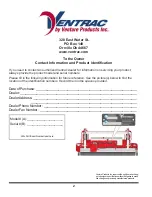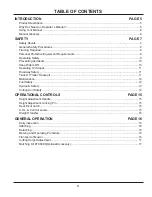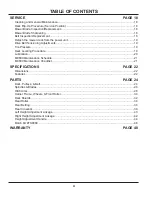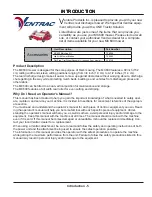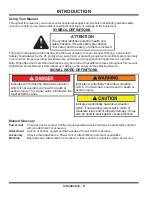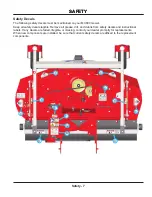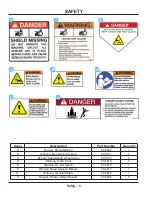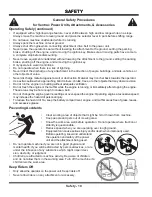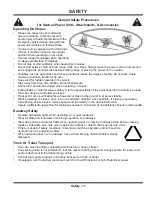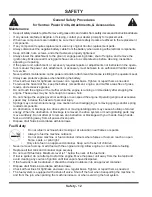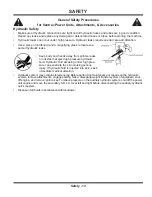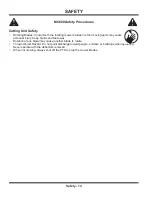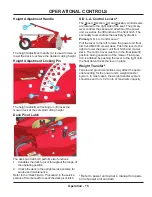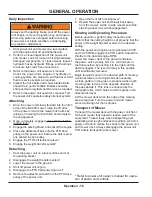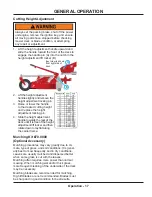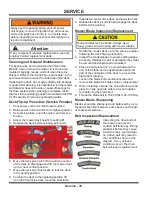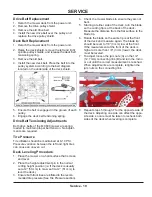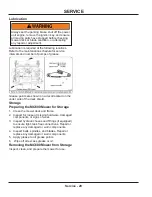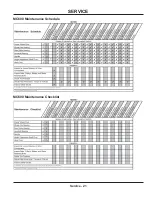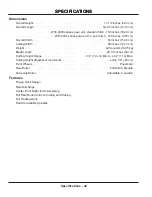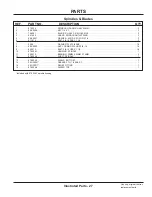
SAFETY
Safety - 12
General Safety Procedures
for Ventrac Power Units, Attachments, & Accessories
Maintenance
•
Keep all safety decals legible. Remove all grease dirt, and debris from safety decals and instructional labels.
•
If any decals are faded, illegible, or missing, contact your dealer promptly for replacements.
•
When new components are installed, be sure that current safety decals are affi xed to the replacement
components.
•
If any component requires replacement, use only original Ventrac replacement parts.
•
Always disconnect the negative battery cable from the battery when working with electrical components.
•
Keep all bolts, nuts, screws, and other fasteners properly tightened.
•
Always lower the attachment to the ground, engage parking brake, shut off engine, and remove the
ignition key. Make sure all moving parts have come to a complete stop before cleaning, inspection,
adjusting or repairing.
•
If the power unit, attachment, or accessory requires repairs or adjustments not instructed in the opera-
tor’s manual, the power unit, attachment, or accessory must be taken to an authorized Ventrac dealer
for service.
•
Never perform maintenance on the power unit and/or attachment if someone is sitting in the operator’s seat.
•
Always use protective glasses when handling the battery.
•
Check all fuel lines for tightness and wear on a regular basis. Tighten or repair them as needed.
•
To reduce the hazard of fi re, keep the battery compartment, engine, and muffl er areas free of grass,
leaves, and excessive grease.
•
Do not touch the engine or the muffl er while the engine is running or immediately after stopping the
engine. These areas may be hot enough to cause a burn.
•
Do not change the engine governor settings or over-speed the engine. Operating engine at excessive
speed may increase the hazard of personal injury.
•
Springs may contain stored energy. Use caution when disengaging or removing springs and/or spring
loaded components.
•
An obstruction or blockage in a drive system or moving/rotating parts may cause a buildup of stored
energy. When the obstruction or blockage is removed, the drive system or moving/rotating parts may
move suddenly. Do not attempt to remove an obstruction or blockage with your hands. Keep hands,
feet, and clothing away from all power-driven parts.
•
Dispose of all fl uids in accordance with local laws.
Fuel Safety
•
Do not refuel machine while smoking or at a location near fl ames or sparks.
•
Always refuel the machine outdoors.
•
Do not store machine or fuel container indoors where fumes or fuel can reach an open
fl ame, spark, or pilot light.
•
Only store fuel in an approved container. Keep out of reach of children.
•
Never remove fuel cap or add fuel with the engine running. Allow engine to cool before refueling.
•
Replace all fuel tank and container caps securely.
•
Do not overfi ll fuel tank. Maximum level is 1” below the neck of the fuel tank.
•
If fuel is spilled, do not attempt to start the engine. Move the power unit away from the fuel spill and
avoid creating any source of ignition until fuel vapors have dissipated.
•
If the fuel tank must be drained, it should be drained outdoors into an approved container.
•
Dispose of all fl uids in accordance with local laws.
•
Check all fuel lines for tightness and wear on a regular basis. Tighten or repair them as needed.
•
The fuel system is equipped with a shut-off valve. Shut off the fuel when transporting the machine to
and from the job, when parking the machine indoors, or when servicing the fuel system.


